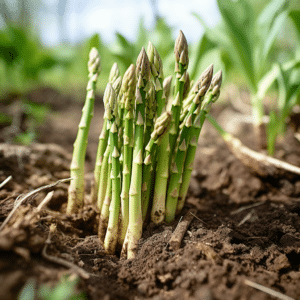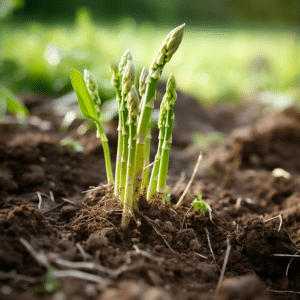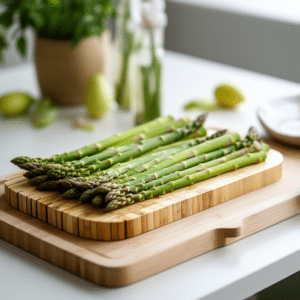Asparagus, a perennial vegetable that adds a touch of gourmet to any dish, is surprisingly easy to grow at home. With the right care and attention, you can enjoy a bountiful harvest for years to come. This guide will walk you through the process of growing asparagus, from planting to harvesting, and everything in between.
Understanding Asparagus

Before diving into the how-to of growing asparagus, it’s important to understand this unique vegetable. Asparagus is a perennial plant, meaning it can live for several years, producing spears each spring. It’s a member of the lily family, and its spears are actually the shoots of the plant, which, if not harvested, would grow into tall fern-like branches.
Asparagus is known for its distinct flavor, which can be described as bright and clean with earthy undertones. It’s packed with nutrients, including fiber, folate, vitamins A, C, E and K, as well as chromium, a trace mineral that enhances the ability of insulin to transport glucose from the bloodstream into cells.
Choosing the Right Asparagus Variety
There are several varieties of asparagus available, each with its own unique characteristics. The right variety for you depends on your personal taste and the specific conditions of your garden.
Some popular varieties include ‘Mary Washington’, a traditional variety known for its resistance to diseases, and ‘Jersey Knight’, which produces high yields of thick, flavorful spears. For something a little different, ‘Purple Passion’ offers sweet, purple spears that turn green when cooked.
Preparing the Soil for Asparagus
Asparagus thrives in well-drained soil with a pH between 6.5 and 7.5. To prepare your soil for asparagus, start by removing any weeds or grass from the area. Then, add plenty of organic matter, such as compost or well-rotted manure, to improve the soil’s fertility and drainage.
It’s also a good idea to test your soil’s pH level. If it’s too acidic (below 6.5), you can add lime to raise the pH. If it’s too alkaline (above 7.5), you can add sulfur to lower the pH. Remember, asparagus is a long-term crop, so take the time to prepare your soil properly.
Planting Asparagus

When to Plant Asparagus
Asparagus is typically planted in the early spring, as soon as the soil can be worked. However, in milder climates, it can also be planted in the fall.
Asparagus is usually grown from one-year-old plants known as crowns. These crowns should be planted as soon as possible after you receive them. If you can’t plant them immediately, store them in a cool, moist place.
How to Plant Asparagus
Start by digging a trench about 12 inches wide and 6 inches deep. Space the asparagus crowns 15 to 18 inches apart in the trench, spreading their roots out evenly. Cover the crowns with 2 to 3 inches of soil, and water thoroughly.
As the asparagus grows, gradually fill in the trench with more soil, but be careful not to bury the emerging spears. By the end of the growing season, the soil should be level with the rest of your garden.
Caring for Asparagus
Once established, asparagus requires minimal care. However, there are a few key things to keep in mind to ensure a healthy, productive crop.
Firstly, water your asparagus regularly, especially during dry spells. Asparagus has deep roots, so it’s better to water deeply less often than to water shallowly more often. Secondly, feed your asparagus with a balanced fertilizer in the spring and fall to promote strong growth.
Finally, keep the asparagus bed free of weeds, which can compete with the asparagus for nutrients and water. Mulching with organic matter can help suppress weeds and conserve moisture.
Harvesting Asparagus

Patience is key when it comes to harvesting asparagus. In the first year after planting, you should let all the spears grow into ferns to strengthen the plants. In the second year, you can harvest the spears for a few weeks in the spring. By the third year, you can extend the harvest period to about 8 weeks.
To harvest asparagus, simply snap off the spears at ground level when they’re about 8 to 10 inches tall. The spears are best eaten fresh, but they can also be stored in the refrigerator for a few days or preserved by freezing or canning.
Common Asparagus Pests and Diseases
While asparagus is generally a low-maintenance crop, it can be affected by a few pests and diseases. The most common pests include asparagus beetles and cutworms, which can be controlled with organic insecticides or by encouraging beneficial insects.
As for diseases, asparagus is susceptible to fungal diseases such as asparagus rust and fusarium wilt. To prevent these diseases, ensure good air circulation by not planting the asparagus too densely, and avoid overwatering.
Conclusion
With its unique flavor and high nutritional value, asparagus is a great addition to any home garden. By understanding the needs of this perennial vegetable and providing the right care, you can enjoy a bountiful harvest of asparagus for many years to come.
Remember, growing asparagus is a long-term commitment, but the rewards are well worth the wait. So why not give it a try? You might just find that growing asparagus is easier than you think.